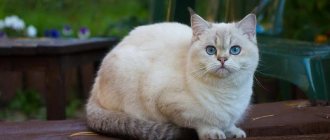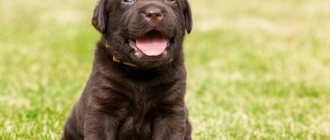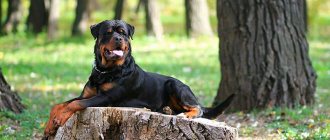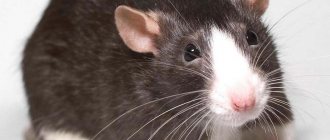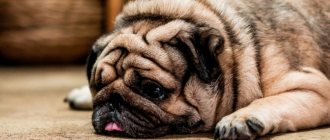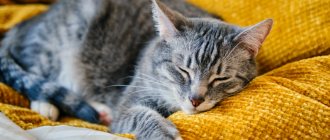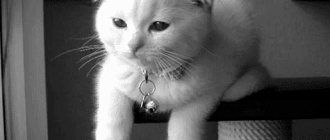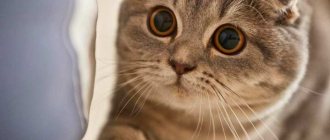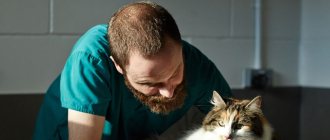To organize proper and complete care for animals, it is necessary to take into account their physiological characteristics in each period of growth. This will allow you to organize competent care, determine the timing of mating, and create a correct and complete diet. Let's figure out what age cats grow to and determine the factors that influence this process.
What is physiological growth
Physiological growth is the process of increasing body size and gaining muscle mass through continuous cell division. The answer to the question of how old cats grow is very ambiguous. The animal grows to the size required by its genetics and breed. For each age, there are certain norms for body size and weight, but there are also individual characteristics. Some physiological and external factors also influence the growth of animals.
In parallel with growth, the development of the cat’s body occurs, the formation and formation of all organs and systems. It is believed that furry pets grow and develop until puberty. Then, this process continues, but not so actively.
Record-breaking animals
The largest cat whose result is recorded in the Guinness Book of Records is the Maine Coon Sweetie from the USA. At 5 years old, he had a length of 123 cm and a tail of 41.5 cm (by the way, Sweetie is also the owner of the longest tail among the representatives of his breed). The cat’s owners said that they didn’t feed their pet anything special, and his growth happened on its own.
Fiz Gel from the USA (Munchkin breed) is recognized as the smallest cat. Her height is only 15 cm. Despite her modest size, she is very mobile: she can easily jump on even the tallest objects.
The Persian Tinker Toy is considered the smallest cat. Its height is only 7 cm and its length is 19 cm. This growth of an adult animal is explained by genetic mutations. But this did not stop the animal from taking its place among the record holders in the book of records.
Sources
- https://usatiki.ru/do-kakogo-vozrasta-rastut-koty-i-koshki/
- https://kinpet.ru/do-kakogo-vozrasta-rastut-koty-i-koshki-raznykh-porod/
- https://gafki.ru/koshki/do-kakogo-vozrasta-rastut.html
- https://vplate.ru/koshki/rastut/
- https://kot-pes.com/do-kakogo-vozrasta-rastut-koty/
- https://pets-expert.ru/do-kakogo-vozrasta-rastut-koty/
- https://pet-mir.ru/do-kakogo-vozrasta-rastut-koty/
[collapse]
Factors influencing the growth and development of a kitten
The main role in regulating body functions (including growth function) belongs to the endocrine system, namely the pituitary gland. The anterior lobe of the pituitary gland produces the growth hormone somatotropin. This biologically active substance ensures the growth of bones and cartilage, and takes part in the formation of muscle mass. No less important is the general hormonal background, which is created by the work of the thyroid gland, reproductive system and adrenal cortex.
There are several other physiological factors that shape the body’s ability to actively grow:
- Breed characteristics. Cats of small breeds go through physical development somewhat faster than their large relatives.
- Belonging to one gender or the other. Males gain weight more actively.
- Hereditary characteristics. The kitten adopts its character and growth characteristics from its parents. You can understand what an animal will be like at the peak of its development by looking at its mother and father.
The rate of physiological growth of cats is greatly influenced by the external circumstances and conditions in which they live and are raised, as well as the characteristics of their care:
- Habitat. If kittens grew up in a cold climate, with few sunny days, then their metabolism was slowed down. This means that they will lag behind in development from their relatives, who have lived their entire lives in the south.
- Lifestyle. Domestic cats living in warm conditions, receiving enough food and all the nutrients they need, have good immunity and develop faster than street animals.
- Amount of sleep and rest. The cat needs to sleep enough time. If in childhood animals are playful and active, then in adulthood the normal amount of sleep for them should be 17-20 hours a day.
- Physical activity also plays a role in development. The animal must be given enough space and opportunities to play.
- Hereditary and acquired diseases. Owners must take all measures to protect their pets from possible infections. In this sense, the importance of preventive vaccinations cannot be overestimated.
- Early castration and sterilization significantly pushes the limit of active growth. After surgery, the rate of growth and weight gain decreases significantly.
- Early pregnancy has a similar effect. After its onset, the priority for the body becomes bearing and then feeding the offspring.
Stages of growing up
Growth limits for each animal are individual, but there are averages. It is known that the phase of most active development ends at the age of 10-15 months. Large breeds such as Britons continue to grow for some time after puberty. Small and medium breeds finish their development earlier. These include, for example, fold-eared and straight-eared Scots (medium breeds), and among small ones - munchkins.
There are several main stages of kitten development (starting from birth). In order for the baby to develop correctly and be in good health, it is important that favorable conditions are created for him at each stage:
- The neonatal period (lasts 4-7 days after birth) is a phase of continuous growth, although it is possible that the kitten will lose some weight during this period.
- The suckling period (lasts 3-3.5 weeks). Rapid weight gain phase. Kittens are rapidly increasing in size and learning to navigate independently.
- Transitional period (lasts from 4 weeks to 2 months). The first teeth appear. At this age, complementary feeding and transition to independent feeding are carried out. There is a significant leap in development.
- Adolescence (lasts until the end of active development). Phase of active and uniform growth. This is the period of formation of the skeletal and endocrine systems. It is important that the diet at this time is of high quality and complete.
Active formation of the bone apparatus lasts up to six months. For proper bone growth, the kitten must receive sufficient amounts of calcium and vitamin D during this period.
Cats stop growing by the age of 3, and cats already look like adult animals at 2 years of age. At this time, their ovaries activate. After the bone skeleton and muscle corset have completed their formation, an increase in body weight and size occurs only due to the accumulation of fat.
Providing ideal conditions for development
The first five months of a kitten's life are especially important. This period determines how actively and qualitatively their future life will be. The owner must do everything to ensure that the development of the small organism proceeds correctly. Proper care is of great importance. During this period, the conditions in which kittens grow must be ideal:
- Stable air temperature (about 20 degrees Celsius) and humidity (about 55%).
- Maintaining hygiene. The cat's nest should be cleaned regularly. At the bottom there should be a special bedding that absorbs urine, liquid feces and traps pathogens.
- Protection from parasites. The first deworming should be done at the age of 8 months. Constant protection against skin parasites, fleas and ticks is also important.
- When transferring to independent feeding, it is necessary to ensure that the kitten’s diet is rich in vitamins and balanced in the amount of nutrients and microelements.
Reasons for slow growth in kittens
There are several reasons why the active growth and development of kittens in the first important year of life can be significantly slowed down. Here are the main ones:
- Insufficient or inadequate nutrition. In the first months of life, the kitten may not have enough mother's milk. When transferred to independent feeding, he may suffer from a monotonous and incorrectly selected diet, poor in vitamins and minerals.
- Hereditary deviations. If the kitten’s parents suffered from genetic pathologies, then the likelihood that they will be passed on to the baby is very high. Correcting such deviations is difficult, and in many cases it is not possible.
- Hormonal imbalances. The main cause of hormonal imbalance at a young age is early sterilization or castration. Usually, the body of a kitten that has survived such an operation stops developing for some time. Over time, this process is restored.
- Viral and infectious diseases. An infectious disease often causes complications in the stomach or intestines. This affects the absorption of food and microelements necessary for growth.
- Helminthic infestations. Parasites take away a significant portion of the nutrients that come from food, so even with a good appetite, the baby becomes thin and slows down its growth. Preventive quarterly deworming is a salvation.
Vitamins for pets
To normalize the development of cats, experts usually prescribe a complex of vitamins. Their choice is influenced by the following factors.
- If an animal eats natural food or cheap feed, it must be given additional vitamins in the form of tablets.
- If the cat eats expensive specialized food, he will only need a product that stops shedding, since premium food already contains all the necessary vitamins and minerals.
- When the animal has already reached maturity, you can purchase a special vitamin complex at the pharmacy, which contributes to the overall strengthening of the body.
- Special vitamins are available for sale for sterilized cats. This applies to both pregnant and lactating cats. There are also special vitamin complexes for neutered cats.
- If your pet is already old, pamper him with vitamins that were created to slow down the aging process.
- To increase muscle mass, you can purchase animal feed protein.
When choosing vitamins for a cat, no matter what age it is, be sure to read the composition and choose a product that contains taurine, a special acid that is responsible for the entire cat’s body as a whole.
Ways to enhance the growth and development of kittens
A veterinarian will help determine the cause of slow growth and development. If these are endocrine disorders or hormonal imbalances, the doctor may prescribe injections of drugs that normalize metabolism and stimulate accelerated growth. These include kartinina chloride (growth vitamin), Gamavit, Milgamma (vitamin B complex).
A kitten that is lagging in growth and development must be surrounded with care and attention. It has been proven that an animal that is loved, caressed, praised and stroked grows well and gains weight.
Why is an adult cat no worse than a kitten?
Many people, when choosing a pet, want to have a kitten because they want to enjoy its growing up.
However, as we have already found out, a cat will grow and change throughout its life. Therefore, when choosing an adult cat, you will not lose the joy of watching your pet develop.
All ages undoubtedly have their pros and cons. Whether your cat is small and playful or mature and affectionate, he will still love you more than anyone in the world. Believe me, you will be the most important person on earth for him!
“Murkoshi” employees note: sometimes an emotional connection immediately arises between a cat and a person. That is why people who, before visiting the shelter, were not even 100% sure that they would adopt a pet, often immediately choose their own special cat, no matter what age it is. Come to our shelter, maybe you too will join the ranks of happy owners!
Features of growth of large breeds
There are several artificially bred cat breeds, the representatives of which are particularly large in size. The most common of them are the following:
- Maine Coons;
- Bengal breed;
- British breed.
Let's look at the age at which large breed cats grow, and what size they can reach with good care.
Bengal breed
Kittens are born very small, their weight does not exceed 120 grams. During the first month of life, kittens gain weight up to 500 grams. Then active development stops, and by the age of 3 months the weight is a little more than one kilogram. At 7 months the process slows down even more, but continues to progress. Animals gain the bulk of kilograms in the first two years of their existence. Regular cats weigh 7-8 kg at 5 years old, while castrated cats can reach 10 kg.
Maine Coons
The weight of a newborn Maine Coon can be 170 grams. By gaining 10 grams in weight every day, a kitten aged 10 days becomes 2 times heavier, by 28 days - 4 times heavier, and by 8 weeks - 8 times heavier. At the age of 4-5 months, the kitten's peak growth activity occurs. At this time, its energy costs are greatest. Bone growth continues for up to 1.5 years, after which muscle mass develops and the animal grows in breadth. A cat reaches its peak of development at the age of 3-5 years. At this time, his weight can increase to 10 kg.
Average age
The lifespan of a domestic cat, determined by genetic factors, ranges from 10 to 15 years, but long-livers live up to 20 years, which approximately corresponds to 100 years of human life.
If we compare human age with the age of a cat, then the age of a kitten at 1 month approximately corresponds to the age of a 6-month-old child and beyond:
- 2 months – 10 months;
- 3 months – 2 years;
- 4 months – 5 years;
- 5 months – 8 years;
- 6 months – 14 years;
- 7 months – 15 years;
- 8 months – 16 years;
- 1 year – 18 years;
- 3 years – 30;
- 5 years – 40;
- 8 years – 50;
- 10 years – 60;
- 12 years – 70;
- 18 years old – 80;
- 19 – 90;
- 20 – 100.
That is, for a cat, the age of 3-4 years is the average age by human standards.
Whether a pet belongs to a particular breed, to some extent, influences life expectancy.
For different breeds of domestic cats, these indicators are slightly different:
- Sphinxes, British - 15;
- Snow Shoe – 10;
- Persian breed - from 15 to 20;
- Asian longhaired cats – 18;
- Australian Longhair – 17;
- Siamese - 20;
- Russian Blues – 19.

